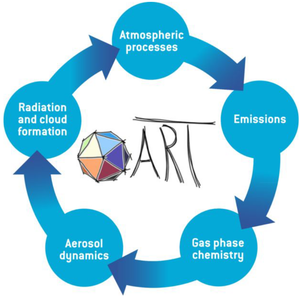Getting Started: Difference between revisions
(used the pandoc -> mediawiki markdown converted text instead of pandoc -> html) |
(uploaded and included capabilities and seamless prediction figures) |
||
| Line 5: | Line 5: | ||
ICON-ART is a state-of-the-science seamless model system for the whole atmosphere (physics and composition) that comprises the key components of the next generation Earth system model in Germany. ICON is a global weather and climate model solves the full three-dimensional non-hydrostatic and compressible Navier-Stokes equations on an icosahedral grid and allows seamless predictions from local to global scales. Aerosol and Reactive Trace gases (ART), as a submodule of ICON, supplements the model by including emissions, transport, gas phase chemistry, and aerosol dynamics in the troposphere and stratosphere (as seen in figure [[#ART-capabilities|1.1]]). |
ICON-ART is a state-of-the-science seamless model system for the whole atmosphere (physics and composition) that comprises the key components of the next generation Earth system model in Germany. ICON is a global weather and climate model solves the full three-dimensional non-hydrostatic and compressible Navier-Stokes equations on an icosahedral grid and allows seamless predictions from local to global scales. Aerosol and Reactive Trace gases (ART), as a submodule of ICON, supplements the model by including emissions, transport, gas phase chemistry, and aerosol dynamics in the troposphere and stratosphere (as seen in figure [[#ART-capabilities|1.1]]). |
||
[[File: |
[[File:ART-capabilities.png|thumb|none|alt=Capabilities of ICON-ART and how they relate to each other.|Capabilities of ICON-ART and how they relate to each other.]] |
||
Being a seamless model makes it possible to use ART to simulate processes overarching multiple scales, like the emission of greenhouse gases, aerosol-cloud interactions and atmospheric chemistry as indicated in figure [[#ART-seamless|1.2]]. It also enables its use as a prediction tool for the production of renewable energy. |
Being a seamless model makes it possible to use ART to simulate processes overarching multiple scales, like the emission of greenhouse gases, aerosol-cloud interactions and atmospheric chemistry as indicated in figure [[#ART-seamless|1.2]]. It also enables its use as a prediction tool for the production of renewable energy. |
||
[[File: |
[[File:ART-seamless.png|thumb|none|alt=ICON-ART’s cpabilities for seamless prediction.|ICON-ART’s cpabilities for seamless prediction.]] |
||
== Getting the source code == |
== Getting the source code == |
||
Revision as of 14:35, 7 September 2022
Getting Started
Overview
ICON-ART is a state-of-the-science seamless model system for the whole atmosphere (physics and composition) that comprises the key components of the next generation Earth system model in Germany. ICON is a global weather and climate model solves the full three-dimensional non-hydrostatic and compressible Navier-Stokes equations on an icosahedral grid and allows seamless predictions from local to global scales. Aerosol and Reactive Trace gases (ART), as a submodule of ICON, supplements the model by including emissions, transport, gas phase chemistry, and aerosol dynamics in the troposphere and stratosphere (as seen in figure 1.1).
Being a seamless model makes it possible to use ART to simulate processes overarching multiple scales, like the emission of greenhouse gases, aerosol-cloud interactions and atmospheric chemistry as indicated in figure 1.2. It also enables its use as a prediction tool for the production of renewable energy.
Getting the source code
Last Update: 2014/06/18 Daniel Rieger
A user who wants to work with ICON-ART has to sign the ICON license agreement with the German Weatherservice (DWD) and Max-Planck-Institute for Meteorology (MPI-M) first. Further information can be found on the following website:
https://code.mpimet.mpg.de/projects/iconpublic
In order to obtain the ART code, the institution that wants to use ICON-ART has to sign an additional license agreement with Karlsruhe Institute of Technology (KIT). Further information can be found on the following website:
http://icon-art.imk-tro.kit.edu
After you have signed the license agreement, you will be provided with a compressed file with the recent source code of ART which is called ART-v<X>.<YY>.tar.gz. <X> and <YY> indicate the version numbers.
Installation
Last Update: 2016/05/25 Jonas Straub
In this section, a brief description of how to compile ICON-ART is given. The user has to do the same steps as compiling ICON with a few additions. The reader is referred to in order to compile ICON successfully. First, the ART-v<X>.<YY>.tar.gz file has to uncompressed. You will obtain a directory, which should be copied inside the ICON source directory $ICON-DIR/src/. In the following, we refer to this directory
$ICON-DIR/src/ART-v<X>.<YY> as $ARTDIR.
If you have compiled ICON as recommended first without ART, you have to do clean up first:
make distclean
In order to compile ICON-ART, an additional flag has to be set at the configuration command:
./configure --with-fortran=cray --with-art
By setting –with-art a compiler flag -D__ICON_ART is set. This flag tells the preprocessor to compile the code inside the ART interfaces and hence connect the ICON code with the ART code. As soon as the configuration is finished, you can start to compile the ICON-ART code:
./build_command
Running a Job
Last Update: 2016/05/25 Jonas Straub
For a user who succeeded in running the ICON model, there are only a few steps to run the ART extension along with the ICON model. A description how to run the ICON model can be found in .
In order to run ICON-ART, one has to do the following steps:
- Configure the code with the additional flag –enable-art as described in .
- Prepare the input data
- Inside the runscript in the namelist run_nml, set the main switch for ICON-ART to true: lart = .true.
- Add a namelist art_nml and choose the namelist parameters for the ART setup as described in .
- Adapt the XML files for tracers, emi. The number of tracers related to a specific setup is equal to the number of possible prognostic output fields as described in .
- Add an output namelist as described in for the species you are interested in.
- Submit the job analogous to an ICON job.

